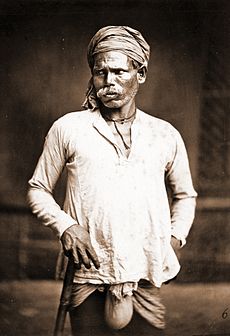Domba
This article needs additional citations for verification. (January 2009) |

The Domba or Dom (Sanskrit ḍoma, dialectally also Dombo, Domra, Domaka, Dombari and variants) are an ethnic group, or groups, scattered across India.
Background[]
Many are nomadic and peripatetic groups in Uttar Pradesh are said to be of Dom origin such as the Bangali, Bhantu, Bazigar, Habura, Kanjar, and Sansi. It could also be that term Dom is generically used to describe any peripatetic nomad, as all these groups mentioned are distinct and strictly endogamous. Some speak a dialect or argot of their own, while others speak the prevailing dialect or language.[1] The 2011 Census of India for Uttar Pradesh showed the Dom as a Scheduled Caste with a population of 110,353.[2] It is also believed that the Dom or Domi people of the Middle East, in addition to the Roma of Europe, and ancestors of Sinhalese people[3][need quotation to verify] are descendants of Domba.
Indian states[]
Its presumed root, ḍom, which is connected with drumming, is linked to damara and damaru, Sanskrit terms for "drum" and the Sanskrit verbal root डम् ḍam- 'to sound (as a drum)', perhaps a loan from Dravidian, e.g. Kannada ḍamāra 'a pair of kettle-drums', and Telugu ṭamaṭama 'a drum, tomtom'.[4]
The people are called Bericho, Dom, or Doma. The Dom identity developed out of their work as musicians. They are a heterogeneous group, descended from a number of families that took up service with the various local rulers. The Dom belong to the Nizari Ismaili sect in Hunza.[5]
There are around 706,000 Doms in Odisha.[6]
In Varanasi, the Hindu holy city in Uttar Pradesh, the Dom perform the most important task of cremation of dead bodies.
See also[]
References[]
- ^ Nomads in India : proceedings of the National Seminar / edited by P.K. Misra, K.C. Malhotra
- ^ "A-10 Individual Scheduled Caste Primary Census Abstract Data and its Appendix – Uttar Pradesh". Registrar General & Census Commissioner, India. Retrieved 6 February 2017.
- ^ Matras, Yaron (1 June 1995). Romani in Contact. John Benjamins Publishing Company. p. 21. ISBN 978-9-02727-648-3.
- ^ T. Burrow and M.B. Emeneau, A Dravidian Etymological Dictionary 2nd ed. (Oxford: Clarendon Press, 1984), p. 257, entry #2949.
- ^ Disappearing peoples? : indigenous groups and ethnic minorities in South and Central Asia. Brower, Barbara Anne., Johnston, Barbara Rose. Walnut Creek, CA: Left Coast Press. 2007. ISBN 978-1-59874-726-3. OCLC 647914842.
{{cite book}}: CS1 maint: others (link) - ^ "Census of India Website : Office of the Registrar General & Census Commissioner, India". censusindia.gov.in. Retrieved 11 May 2020.
External links[]
- Dom in Bangladesh
- Dom in Pakistan
- Dom in India
- Ethnic groups in India
- Ethnic groups in Bangladesh
- Dalit communities
- Shudra castes
- Scheduled Castes of Uttar Pradesh
- Scheduled Castes of Tamil Nadu
- Scheduled Castes of Bihar
- Scheduled Castes of West Bengal
- Scheduled Castes of Jharkhand
- Scheduled Castes of Odisha
- Scheduled Castes of Assam
- Scheduled Castes of Madhya Pradesh
- Scheduled Castes of Chhattisgarh